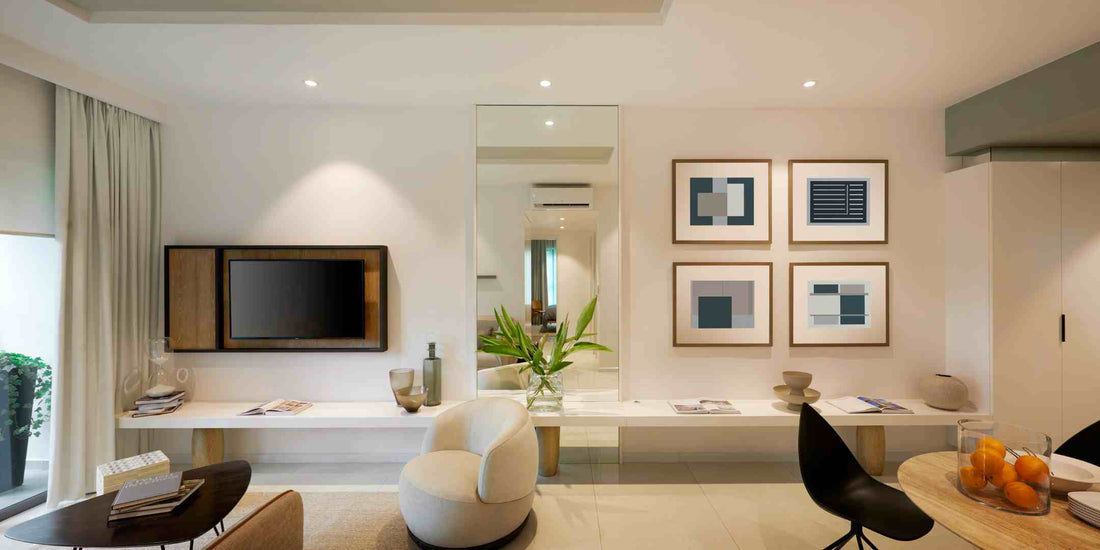
How To Highlight Artwork and Décor with Lighting
Share
Learning how to light up artwork isn't just for curators or luxury designers. Homeowners, contractors, and even DIY decorators can achieve the same effect at home. Whether you want to highlight a family portrait, a gallery wall of travel prints, or a statement sculpture in your living room, the proper lighting can turn décor into a focal point.
So let's break down how to do it right.
Lighting Art Work? It Matters!

Artwork is more than decoration. It tells your story. Lighting helps tell that story with clarity. Without proper lighting, textures get lost, colors dull down, and that bold abstract canvas you paid good money for just looks…meh.
Well-planned lighting:
- Adds depth and dimension to your walls
- Creates ambiance in the space
- Highlights details and textures
- Guides the eye toward your focal point
Let's Touch on The Basics
The first step is understanding your options.
1. Picture Lights For That Warm, Focused Glow
These are classics for a reason. Mounted directly above a painting or photograph, picture lights gently illuminate the artwork with a warm, focused glow. They're great for highlighting family portraits, oil paintings, or framed prints.
2. Track Lights To Highlight Larger Collections
It allows you to adjust individual heads to spotlight multiple artworks simultaneously.
3. Wall Washers To Achieve A Dramatic Gallery
Instead of spotlighting one piece, wall washers evenly spread light across an entire wall or gallery.
4. Accent Recessed Lighting For A Sleek Unobstructive Effect
They create the illusion that the artwork is glowing on its own.
5. Uplighting & Downlighting
For sculptures and three-dimensional décor, uplighting from the floor or downlighting from the ceiling creates a dramatic effect. This trick works wonders on architectural features as well.
Placement Tricks:
Angle it right: A 30-degree angle is the sweet spot to avoid glare and shadows. For larger pieces, increase to 35 degrees.
Distance matters: Too close and you’ll create hotspots; too far and you’ll lose intensity.
Height hack: Install fixtures slightly above eye level so the light naturally flows down across the piece.
Don’t forget spacing: For gallery walls, aim for even coverage—no one print should hog all the attention.
Highlighting Décor Beyond Art
When people ask, “How to light up artwork?”, we always add: don’t stop at the canvas. Décor pieces—sculptures, vases, textured walls, even plants—deserve their spotlight too.
- Floating shelves: Add LED strip lights under shelves to highlight curated décor.
- Sculptures: Use uplights at the base for a museum-like effect.
- Accent walls: Try wall grazers to enhance textures like bricks, stones or wood.
- Mirrors: Backlighting creates depth and a soft halo effect that elevates the whole space.
Common Mistakes to Avoid
Even with the best intentions, lighting can go wrong. Here’s what to watch for:
- Glare on glass: Art behind glass needs angled lighting to avoid reflections.
- Too much heat: Hot bulbs near delicate works = fading and damage.
- Uneven coverage: Don’t leave one piece glowing while the rest sit in the dark.
- Wrong color temperature: Cool light makes warm artwork look washed out; overly warm light can distort"modern art"
DIY-Friendly Solutions
Not ready for a full rewire? Here’s how to highlight your artwork without a professional electrician:
- Plug-in picture lights: Mount above frames—no wiring required.
- Battery-operated puck lights: Great for shelves or shadow boxes.
- Adhesive LED strips: Affordable, renter-friendly, and versatile.
- Portable accent lamps: Place on side tables to bounce light toward décor.
These DIY lighting ideas are perfect for renters or anyone wanting a quick weekend project.
Layered Lighting: The Designer's Secret
Just as we layer general, task, and accent lighting in a room, the same applies to artwork. Try this combo:
- Ambient lighting for overall brightness.
- Accent lighting (picture lights, spotlights) for focal points.
- Decorative lighting (lamps, candles, LED strips) for mood.
The layering makes the space dynamic and prevents the “spotlight interrogation” look.
So, how to light up artwork? The key is intentionality.

Choose the right fixture, select bulbs that complement the art’s colors, and position the lights thoughtfully. Whether it’s a single cherished painting or an entire gallery wall, the right glow transforms it from background filler into the centerpiece it was always meant to be.
Lighting is one of the most straightforward yet most potent tools a homeowner, contractor, or DIYer can use to elevate décor. And unlike a new sofa or remodel, it doesn’t require a huge investment, just a little know-how and a willingness to experiment.
So next time you hang a piece of art or set out your favorite décor, ask yourself: “What’s its spotlight moment?” Then light it up accordingly.
